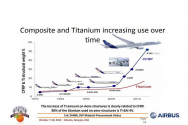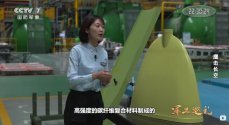On the other hand, there isn't any concrete proof that such material changes must result in the degree of redesign and changes that you have mentioned. Without any concrete proof to suggest if either case is necessarily true, I suggest that everyone just take a step back.
I invite you to examine relevant real-world examples, one of which I actually mentioned.
Also, may I point out that there have been Chinese reports that stated that at least for J-11B, “under Yining Zhang's leadership, 4 major parts, including the wing, vertical stabilizers and horizontal stabilizers have been replaced with composite materials” There have also been papers that stated that the Chinese have switched from welded titanium bulkheads that the Russians were using to die-forged titanium bulkheads which are partially one-piece (bad translation on my part, basically means they're able to die-forge larger pieces of the bulkheads and do less welding) with significant weight reductions, strength increases as well as an increased fatigue strength and service life.
I can completely believe the single-piece titanium bulkheads, integrating formerly separate parts into larger machined parts is the kind of improvement you commonly see between successive aircraft variants. Gripen C vs. A, or Su-30MK & -35 vs. Su-27 are great examples. That's a lot less of a change than going to composite though, which due to its vastly different mechanical properties requires the shape of highly loaded parts to be completely redesigned.
Kind of irrelevant too, because 1) titanium is not composite and 2) the argument was about structural improvements in Chinese Flankers that are not found in their Russian counterparts. As mentioned, increased use of integral machining features extensively on the Su-30MK and Su-35, however.
p.s. the 4th missing "major part" in the article seems to be the air intake section by some accounts. One of Sun Cong and Wang Xiangming's co-publications, "飞机结构典型故障分析与设计改进", also talks about problems encountered during the process of switching to composites for intakes (there may also be mentions of other parts, but I'd need time to check the book for details)
I only found a table of contents in Chinese for this one, Google Translate suggests the only aircraft mentioned is the J-8?
If anything, the fact that they had to indigenize the production line on their own, likely using the techniques most compatible with their own available or desired production competences, makes it logically less likely that the J-11’s structural make and assembly details are one for one identical to the Su-27 than more.
Changing over primary load-bearing structure from metal to composite is not the kind of thing you undertake as a learning exercise though, that works only if you are already highly competent in this field. Again, a look at the wider Chinese aerospace industry doesn't suggest composites would've come into that category at the time in question (or even today, compared to Russia). Integrating parts into larger forgings sounds decidedly more plausible (but is beside the point), as discussed above.
And whether you consider it likely or not, the structural details of the J-11/16 are in many respects closer to the Su-27 than the Su-35 that Justin Bronk considers to be less advanced. It also bears repeating that I'm not necessarily saying the Chinese airframes have no changes or no composites at all, only that there is little evidence that the scale is sufficient to justify Bronk's argument.
Just FYI, he's not talking about the colour, he's talking about the contents of what is spoken in those interviews, which he provides two links to and a screenshot of a relevant portion to.
For example, in that screenshot the image itself is less important than what is being spoken:
"高强度的碳纤维复合材料制成的".
So no, it's not a matter of "look at these yellow parts, which we assume are composites for no good reason".
And instead is "here is a state television documentary on the historical development of the aircraft type and they explicitly mention the use of composite materials".
Come on, you are better than this
If I don't speak the language and (despite the fact that I mentioned this before) explanations are not forthcoming, 'fraid not.
The first link is one that was discussed before and light on specifics (parts concerned, scale), while the screenshot may or may not be J-11 parts (I certainly can't place them anywhere on the aircraft). I've now gone and made screenshots of the segment leading up to and including the shot of the J-11 tails in the second link to capture the subtitles and run them through an image translator. That did confirm beyond all doubt that the tail fins are composite, but the process has taken me the better part of 40 minutes to extract the contents of less than 40 seconds worth of video. I frankly don't think that's a reasonable effort to expect, and remain *very* skeptical about composite application beyond this.



